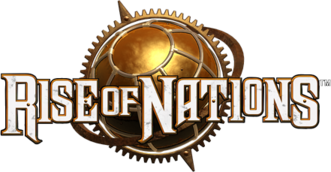| Nation Overview | Strategic Overview | CtW Information | History |
| HEALTH WARNING: Do not assume that this article is a comprehensive account of the history of the Bantu peoples. Rather, think of it as a skimming over of what is clearly one of the most convoluted and intricate (as well as interesting) cultures to exist in the world. |
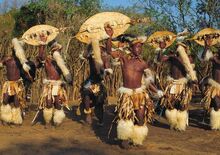
Zulu men performing Indlamu, a traditional dance mostly associated with Zulu culture. It is derived from the Zulu warrior class of past times, and is carried out by men in full warrior regalia; traditional head pieces, ceremonial belts, shields and spears. The Zulu are one of the most noticeable influences on the game's depiction of the Bantu nation.
The term Bantu, refers to a variety of tribes across most of Africa that speak any of the more than five hundred different languages and dialects of the Bantu family. Although they comprise wildly variegated and diverse grups, from simple hunter-gatherers to sophisticated trading nations, the most recognizable Bantu ethnic group in popular culture, and the one Rise of Nations seems to be most based on, is that of the Zulu of southern Africa. In fact, the word itself derives from Abantu (or 'Bantu' as it was used by colonists) which is the word for people in the Zulu language. It is the plural of the word 'umuntu', meaning 'person', and is based on the stem '-ntu' plus the plural prefix 'aba'.
While South Africa's Zulu community comprises the most well-known Bantu ethnicity in Africa today, it is not the only one — almost all nations of central and southern Africa are home to one or more, such as the Kikuyu of Kenya or the Kongo people of Angola and the Congo, as well as the Swahili-speaking peoples of Kenya and Mozambique, who themsleves are descended from Bantu tribes.
Rise of the Bantu (c 2000s BCE)[]
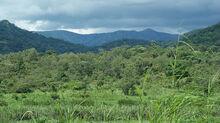
Gashaka Gumti National Park in Nigeria, near the border with Cameroon. It is around this area, the central border between both countries, that the Bantu peoples are believed to have originated, and to have begun their great, centuries-long journey that brought them to most of the African continent.
While it is true that the history of human cultures (or the planet as a while) often can have vast lacunae where there is no history, what is problematic about Bantu history is that there are often more empty gaps than other nations or cultures. What little has been learnt, either through old legends, myths and accounts written by foreigners, must often be corroborated with the spade.
Thus far, current scholarly understanding places the ancestral proto-Bantu homeland in West Africa near the present-day southwestern border of Nigeria and Cameroon, around 4000 years ago (2000 BCE). It is unclear exactly when the spread of Bantu-speakers, called the "Bantu Expansion", began from their core area as hypothesized c. 5000 years ago (3000 BCE). By 3500 years ago (1500 BCE) in the west, Bantu-speaking communities had reached the great Central African rain forest, and by 2,500 years ago (500 BCE), pioneering groups had emerged into the savannahs to the south, in what are now the Democratic Republic of the Congo, Angola, and Zambia. Another stream of migration, moving east, by 3000 years ago (1000 BCE) was creating a major new population center near the Great Lakes of East Africa, where a rich environment supported a dense population. Movements by small groups to the southeast from the Great Lakes region were more rapid, with initial settlements widely dispersed near the coast and near rivers, due to comparatively harsh farming conditions in areas farther from water. Pioneering groups had reached modern KwaZulu-Natal in South Africa by 300 CE along the coast, and the modern Northern Province (encompassed within the former province of the Transvaal) by 500 CE. It is this latter group of colonists from whom the Nguni peoples of southern Africa are descended from, among which were the progenitors of what would become the fabled Zulu kingdom.
The proto-Bantu migrants in the process assimilated and/or displaced a number of earlier inhabitants that they came across, including Pygmy and proto-Khoisan populations in the center and south, respectively. They also encountered some Cushitic- and Nilotic-speaking outlier groups in the southeast, who had migrated down from Northeast Africa, and Bantu-speakers may have adopted livestock husbandry from them, since herding practices reached the far south several centuries before Bantu-speaking migrants did. Archaeological, linguistic, genetic, and environmental evidence all support the conclusion that the Bantu expansion was a significant human migration.
The Iron Age[]
Iron Age technology was transmitted across Africa by Bantu-speaking people who migrated to the south from North and Central Africa. Their language and culture mixed with those of the groups they met, which is why many African people are Bantu-speaking. They also brought iron smelting technology and agriculture to these groups and founded great kingdoms like Great Zimbabwe, Mapungubwe (Limpopo basin) and Thulamela (South Africa's Kruger National Park).
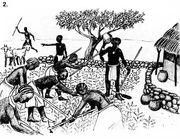
Depiction of life in a pre-modern Tswana village (near present-day Botswana). Settlements like these became commonplace for the Bantu peoples in the Iron Age.
Before the Iron Age in southern Africa, most people were nomadic and survived by hunting wild animals and gathering wild plants. Most chiefdoms were small in size and people did not regard land as property. This resulted in fairly harmonious co-existence as no tribe needed to be or was sufficiently more powerful to conquer another. Some scientists say this was helped by the abundance of resources. Food and water were readily available and people simply followed the animals they hunted as the seasons changed. This made the nomadic life more practical than settling in one place.
Nevertheless, agriculture began to become more widespread and as it did, people settled in villages and towns and gathered together their cattle in an enclosure called a kraal in the centre of their settlement. Farming allowed people to settle in towns. Their communities became more organised and political leaders emerged. They didn't have to rely on the availability of wild animals or plants any longer but could produce their own food. As towns grew and developed, society became more complex, paving the way for more sophisticated administration and politics. Now that communities could cultivate plant crops and raise livestock, especially cattle, they sometimes had too much of both.
This surplus became the object of trade. Groups began to exchange their products for goods they couldn't produce themselves. Trade routes were established and ivory and gold from Africa was traded for cloth, glass beads and other luxury products from afar.
Medieval Africa[]
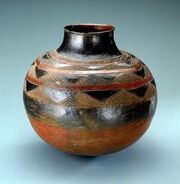
A traditional jar made by the Shona, a Bantu-speaking tribe. It is said that a branch of the Shona tribes eventually founded many great kingdoms, most notably Great Zimbabwe.
The first empire of note in southern Africa is thought to be the so-called BaChwezi dynasty (c pre-1300s CE, Uganda). As mentioned before, almost little was known of it beyond the many myths and legends told by their so-called successors, the much later Bunyoro-Kitara empire, who attributed to them a demigodly status and whose descendents (now in present day Uganda) still worship them as ancestor spirits. Excavations of a site attributed to the Chwezi at Bigo near the small town of Sembabule in southwestern Uganda uncovered a massive fortification complex of impressive dimensions, replete with various artefacts, especially pottery, implying that Bigo was a highly urbanised area in its prime. It is interesting to note that Bigo was located in a defensible area, bordered by a large marshy area on one end, and then having access to the Katonga river, which feeds into both Lake Edward at its western end, as well as Lake Victoria in the east. This would have made it highly useful as a trading waystation between the cultures that had colonised the areas around both lakes, perhaps necessitating the need of the aforesaid earthworks.
While the Chwezi people left little physical traces, the next two powers to appear in southern Africa are perhaps more famous - the one by the splendour of its monuments and artefacts, the other by having secured its place in the historical records. The first was the kingdom of Mutapa (better known to us as Zimbabwe) and the latter, the kingdom of Kongo. Further north, the expansion and consolidation of Islamic influence, as well as the mediaeval revival of Christian Europe, would soon bring the Bantu peoples in contact with other civilisations and begin to make their mark on the world through trade.
Trade and Commerce: The Arrival of Islam[]
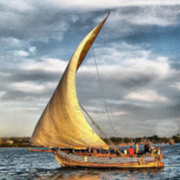
A dhow off the Swahili Coast of Africa. Being easy to reach from Asia by ship thanks to favorable wind and ocean currents turned the northern half of East Africa into a veritable trading power.
In the early Middle Ages, Islam had already spread into northern Africa by the mid-seventh century CE, only a few decades after the prophet Muhammad moved with his followers from Mecca to Medina on the neighboring Arabian Peninsula (circa 622CE).
The rise of Islam in East Africa had two effects there - mainly cultural and economic. With the rise of Islam and the integration of Bantu settlements into the Muslim world, socioeconomic and political contacts with the Arabian peninsula, India, and Southeast Asia became all the more frequent. Interracial marriages were not uncommon, and gradually over the centuries, a new and distinct ethnic group developed, known as the Swahili. Thus, although Swahili today has Bantu roots, many words in Swahili have their roots as loanwords from Arabic and Hindi. Access to the Muslim world - since Islam by now was the dominant power in the Indian Ocean - also meant commercial opportunities for the Bantu-speaking peoples of the so-called Swahili Coast.
The Swahili States[]
An important attraction was the gold obtained from inland kingdoms. Trade in goods from the African interior, such as gold, ivory, and slaves stimulated the development of market towns such as Mogadishu, Shanga, Kilwa, and Mombasa. The gold was needed mainly for coins, although it was also used for works of art, ornamentation on buildings, and jewelry. Also, the city-states were easy to reach from Asia by ship because of the favorable wind and ocean currents and in exchange for their keystone products, would import varuious goods from Asia. Many residents of the city-states were willing to pay high prices for cotton, silk, and Chinese porcelain.
Finally, East Africa was a fairly peaceful region, and the few conflicts that did occur were small and brief. All of these factors created an ideal setting for import-export companies to conduct business. Yet while the city-states were famous throughout Africa and Asia, no European countries knew of them. You can imagine the surprise, then, of Portuguese captain Vasco da Gama when in 1498CE he came upon bustling port cities such as Sofala, Kilwa, Mombasa, and Malindi as he sailed up the eastern coast of Africa. He and his crew were welcomed by most of the cities they visited, although neither his ships nor the European items they attempted to trade were of much interest in the East African city-states.
The Southern Kingdoms[]
Even if the Islamic merchant kingdoms of the so-called Swahili coast were not the most significant of all Bantu peoples in southern Africa, the non-Islamic history of the Middle Ages can also just be as fascinating as it is still elusive for many - most information that we know of with regards to place names and people are still passed down orally, providing tantalising clues for would-be archaeologists.
Farther inland and south, commercial contact with Islamic empires had several effects - it created an impetus for sedentary life (in order to control the flow of goods from the central hinterlands to the coast), and also fostered the passage of new ideas and concepts - hence providing the leaven to help new societies and even new social orders to bloom. Thus, by the Middle Ages, a series of states had emerged, centred around present-day Zimbabwe, as well as present-day Congo and Angola farther west, as well as far south as what is today the northern reaches of the Republic of South Africa.
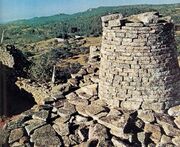
Megalithic fortresses such as the citadel of Great Zimbabwe were built in mediaeval Mozambique and Zimbabwe.
Of these, Zimbabwe looms large in no small part due to the so-called kingdom of "Great Zimbabwe". Founded by the Gokomere culture, a Bantu people who had settled the highlands around the present-day town of Masvingo in Zimbabwe, they eventually would found their own civilisation, the greatest of its landmarks being the ruins of "Great Zimbabwe" (the meaning of the word 'Zimbabwe' is thought to be "stone house"). A massive and monumental citadel consisting of an enclosure with watchtowers and tall mortarless walls, Great Zimbabwe proved to host artefacts of Chinese and Iranian influence, and even had a sophistication network of water conservation channels carved into the hills surrounding it, proving that it was the centre of a massive state with trade links to the rest of littorial south-eastern Africa. And while it would eventually collapse in the early 15th century, its cultural legacy would continue elsewhere — great megalithic fortresses mimicking the citadel of Great Zimbabwe continued being built throughout the areas that would become the contemporary states of Mozambique and Zimbabwe.
Farther west, on the southernmost fringes of the Gulf of Guinea, another Bantu-speaking empire was slowly rising from the jungles - the kingdom of Kongo. By the time of the first Portuguese contacts, Kongo, hitherto a smaller kingdom founded around a settlement by a river by the Mbata people, had through conquest or marriage built up a massive empire that engaged in both metalworking and entrepot trade, most notably in ivory.
Europeans Come Ashore (1400s CE-1800s CE) []
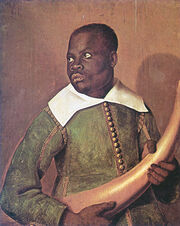
Early Modern Dutch painting of a retainer to a nobleman of Kongo, holding an elephant tusk, a highly prized commodity exported by the Bantu kingdoms of the Middle Ages.
At the end of the 13th century, Europe would see what could be considered one of the biggest bestsellers of all time: Il Millione, otherwise known as The Travels of Marco Polo. Polo's account of Asia would be one of Europe's bestsellers over the next two centuries, catching especially the attention and fancies of merchants....as well as nobles and kings eager to obtain their share of the immense profits overseas trade, then brokered primarily by Venice and Byzantium through contacts with the Muslim Middle East.
By the time Marco Polo died in 1324CE, contacts with the Islamic world and its sciences, as well as increased knowhow from building ships thanks to the now burgeoning trade routes across the Mediterranean and the North Sea would provide mediaeval Europe with its chance at commercial success (through the introduction of two ship classes, the "tall ship" or carrack , and the caravel )....and eventually imperial influence, especially in the lands of the Bantu peoples of Africa.
The Portuguese Empire[]
The kingdom of Portugal was established itself almost two centuries earlier in 1147CE after having seized control of Lisbon in 1147CE from its Muslim overlords, who most certainly had knowledge of the Azores and the Canary Islands, as well as the waters of West Africa. Funded by profits from the sugar trade out of Madeira and the Azores (as well as generous funds by none other than the legendary Medici banking clan of Florence) and seeking a route to the riches of China and India, the Portuguese crown sent Gil Eanes and Bartolomeu Dias to attempt to reach Asia by sea and Pêro da Covilhã across land.
While Covilhã made contact with the Ethiopians of East Africa, Dias managed to make first contact with the Bantu peoples of South Africa on his first voyage. Later, Dias would accompany Cabral on his expedition to Brazil, only to perish off the coast of South Africa as the Portuguese flotilla attempted to reach India in 1500CE. With the exact maritime and land routes to India's shores now properly mapped out and ready for use, there was one problem left for the Portuguese to solve: how to keep their ships sailing and the crews alive long enough to make a trade expedition successful? the answer was simple enough — colonise Africa and set up naval and supply bases to help maintain and supply the ships, and manage their cargoes.
The Slave Trade[]
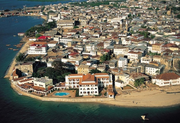
Stone Town, Zanzibar
Because most European nations were small and clearly did not have the manpower advantages that the two largest nations on earth ( Mughal Empire and China) had, slavery was the only choice possible to make colonisation of new nations profitable for the understaffed and increasingly belligerent colonial powers. So from the 16th century onward, the Portuguese would raid coastal towns to seize the inhabitants and forcibly remove them to the Americas.
These raids were not the only source of slaves, however: Africa southwards from the equator was divided up into a bewildering patchwork of nations and polities, with some of these being in frequent conflict with their neighbours. So while the Portuguese were probably the first Europeans to actively deal in African slaves, they however would not (unfortunately) be the last. In their wake, other colonial powers - Spanish, French, English, Dutch, and even Danes and Swedes - all would be active and willing transactors in the slave trade, selling much weapons and powder to African monarchs in exchange for slaves, who would then be shipped back to America to produce merchandise for European markets - which would then mean more weapons to conquer more land and seize more slaves, repeating the process again and again and again.
For this "Atlantic Triangle Trade" to happen, however, it would need local brokers for the trade. The most common suppliers (and possibly users of slaves) were the Bantu-speaking kingdom of Kongo in Central Africa, and the non-Bantu Ashanti and Benin Empires further north on the Gulf of Guinea. Of these, the name of Kongo must be writ large, for Kongo probably has the most secondary sources accessible to the international community and so the great feats and developments this kingdom experienced during the Early Modern Era are very much in plain sight to most of us thanks to her early embracing of Western culture and Catholicism.
Kongo[]
Kongo (from which the name "Congo" itself is derived) was a feudal kingdom which covered northern Angola, and could exert her influence into the west of what is today the DRC. The various sources available to us state that Kongo was first founded by the merger of two earlier kingdoms — Mbata and Mpemba Kasi — in 1375CE.
Kongolese society was organised into villages, made up of big families called kanda, united by a common ancestor. Usually, the head of the kanda was male, but in the 16th and 17th centuries it was also common for women to be in charge. Kongolese women worked in the fields and men gathered materials from trees, producing cloth, palm wine and other goods. There were also towns, which were well-designed and impressive to look at: Portuguese visitors in the 1490s commented on how advanced the royal capital, Mbanza Kongo, was. The state was extremely centralised — one of the Kongolese king's titles was nzambi mpungu, "supreme spirit/creator"; implying that there was a an immense centralisation of power in the monarch. Once more, Portuguese sources illustrate a nation where power was legally absolute, but not uncontested — competition for the throne was fierce: the story of how Pedro I was deposed by his designated successor Diogo I, and attempted to appeal to the Portuguese for help, is testament of how intense political rivalries in Kongo could get.
Kongo, however, didn't exist in a vacuum — there were several other smaller rivals which surrounded her. Warfare was endemic, and thus provided a steady supply of slaves, first for local use, and eventually later for export to the Americas and beyond. Tribute was another source of income for the state. It was these two things. however, which eventually pulled Kongo apart. From Diogo I' s reign, relations between the Portuguese and the Kongolese would suffer even as the kingdom would face multiple threats — military defeats, rivalry with the now ascendant kingdom of Angola to the south, and the spilling over into Africa of the Eighty Years' War in Europe. Along with this came the different aspirations of both the Portuguese (now ensconced on São Tome in the seas off Gabon and Cameroon to the north) and the Kongolese élite. Portugal had a vested interest in controlling the slave trade and ultimately the economy of Kongo, which controlled copper mines; the Kongolese dreamt of creating their own trade fleet to sell slaves direct to Europe and so resented the tomistas (their name for the Portuguese, after São Tome) who conducted slave raids on Kongolese territory and bought slaves through illegal channels.
Civil wars sparked by succession crises after Diogo I sapped the ability of Kongo to wage war, be it against her neighbours or in defence against the Dutch and Portuguese. Attempts to reach out to the Spanish for help were in vain, the Spanish Empire was in decline and in any case had little to gain from interfering, even if they had resources to do so. By the 19th century, however, it was all over: the Dutch had ceded their influence in Africa to the burgeoning British Empire (who were allies of the Portuguese), Angola was annexed by the Portuguese, and Kongo, weakened by dynastic conflict, was in effect a Portuguese vassal.
Zimbabwe[]
The Zulu[]
he Zulu also known as the Zulu Kingdom or Zulu Empire, are a tribe native to the KwaZuluNatal province of South Africa. They rose to power in the 1800s, led by a military genius named Shaka. Thought by many to be to be the most influential Zulu warrior in history, Shaka Zulu reigned as King from 1816 to 1828. He united many scattered clans into one consolidated powerful tribe. The Zulu empire's main battles were with the British settlers, and to a lesser extent, the Dutch and other European settlers. Shaka Zulu was the third born son of Senzangakhona. When Senzangakhona died in 1816, Shaka took over and within twelve years had became the greatest leader of his time, conquering many nations and amalgamated them under his reign, thus creating a huge Zulu nation.
The Modern Era: Crisis, Chaos and Colonisation (1800s CE-1950s CE) []
The French Revolution: End of the Slave Trade[]
While seemingly innocuous (slavery had long existed all over the world, and to a certain extent still does) with imperceptible effects, in the long run slavery would permanently damage Africa, leaving her ripe for European conquest a century or two later once the right technologies were obtained. In previous centuries, the slave trade was seen merely as a supplementary activity meant to defray the costs of warfare - once rival tribes were defeated, their survivors, if any, would be sold off as slaves to Europe and the Middle East. But as the profits from selling these "human cargoes" to America escalated, so did the bitter intensity of conflict, as well as its effect on socioeconomic relations. Instead of developing an economy based on mutual exchange and technological innovation as the West was wont to do over the next few centuries, the "Dark Continent" would instead intensify the race to provide slaves. Warfare was not just for land or for asserting political power, it was now economic as slave raids were conducted by native Africans agains their rivals and their weaker neighbours.
Emancipation after the Napoleonic Wars only made things worse - not only did the European powers ban the slave trade, their countless bitter battles had given birth to a crack corps of mariners who were brutally efficient at curbing the slave trade. Only the Muslim nations - the Ottoman Empire and her neighbours, such as the small sultanate of Zanzibar - would continue purchasing black slaves, but the damage was done. By the time abollition was in full force, countless African nations had become so dependent on the profits of slavery, that they now faced economic ruin. They had devastated their neighbours and their own lands for profit, stunted technological and social innovation, and were now seen as fair game in the coming "Scramble for Africa".
An Ongoing Saga?[]
References[]
- Embleton G & Nicolle D; The Portuguese in the Age of Discovery c.1340–1665; (2012) Osprey Publishing
- Boston University; The Indian Ocean Trade: A Classroom Simulation
- South African History Online
- Fortune of Africa; The Bachwezi Dynasty
- Metropolitan Museum of Art; Trade and the Spread of Islam in Africa
- Right for Education; A Short History of the Kingdom of Kongo
- ScienceAlert; Mysterious Medieval City in Africa Had a Genius System to Survive Drought
- SmartHistory; Benin and the Portuguese
- University of Pennsylvania; East Africa Living Encyclopedia
